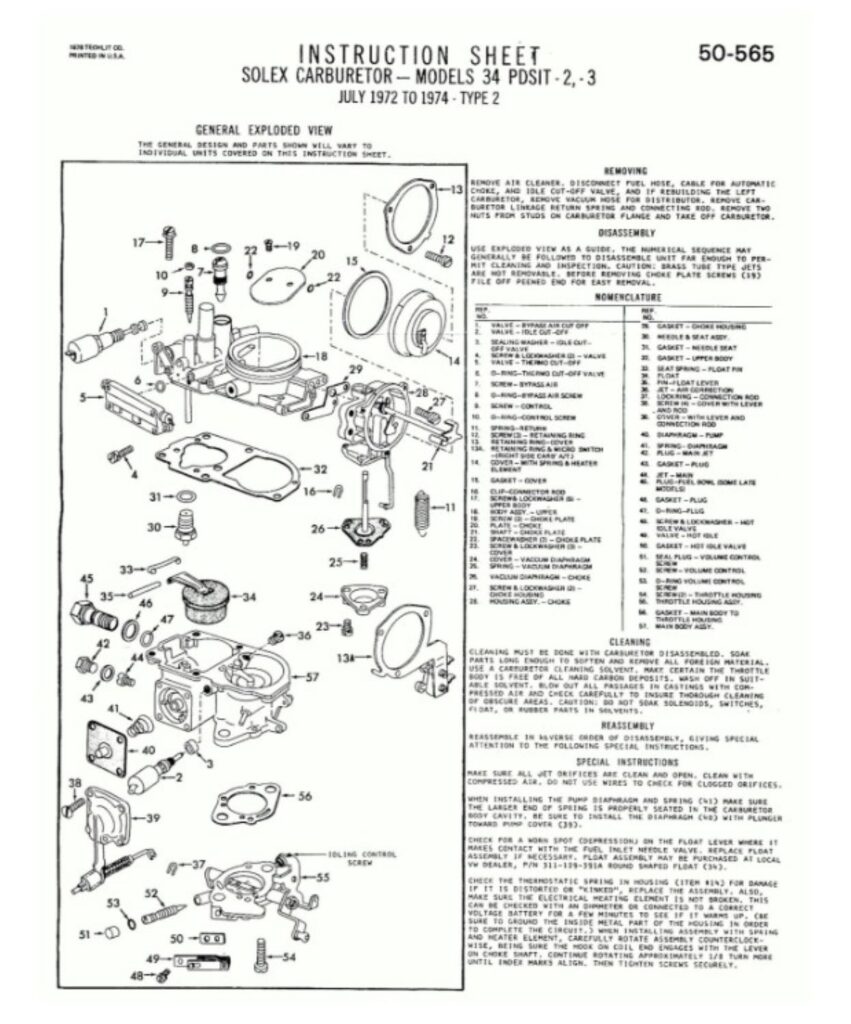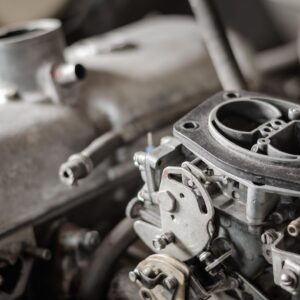Today, most vehicles come with a fuel injection system instead of a carburetor, and to be honest, fuel injection is better for a lot of reasons. Carburetors require a lot of work and adjustment over the life of a vehicle.
A carburetor atomizes fuel using the flow of air coming through the carburetor’s venturi so that the atomized fuel can be carried into the combustion chamber and ignited.
It’s made of several parts, including a venturi tube, a float bowl, and small jets, and they all need cleaning and adjustment sometimes.


Tips for Cleaning Your Carburetor
Cleaning your carburetor is as time-consuming as it sounds, but there are ways to streamline the process. Here are some tips:
Get a Carburetor Kit
You can purchase the right kit for your carburetor. Sometimes you’ll need the tag number for the carburetor but usually that’s only required when buying the kit from the dealer. The best thing about buying a kit is that it comes with all the gaskets, which you’ll need in order to do the job right, and the instruction sheet.

Prepare the Necessary Tools
Before you begin, prepare everything you need. This will save you a lot of time and make it easier to stay in the zone as you work. Some of the tools you’ll need include a Phillips screwdriver, a flathead screwdriver, needle nose pliers, a wire brush, and a wrench set. Don’t forget to get some lacquer thinner or a can of carburetor cleaner.
Disconnect the Battery
You can never be too careful when it comes to cleaning your carburetor. Disconnect the battery before starting, so that you can prevent any sparks from accidentally causing a fire. No smoking.
Remove the Carburetor
Not all vehicles will require you to remove the carburetor before cleaning them. However, doing so can give you much better access to the jets. If you aren’t 100% sure how to safely remove the carburetor, don’t hesitate to ask a mechanic for help.
Use the Correct Carburetor Cleaner
Be sure to get a carburetor cleaner that’s compatible with your vehicle. If your carburetor is made of plastic, go for a carb cleaner that’s specifically formulated for plastic material.
Use Compressed Air
Compressed air can help remove leftover debris and dry the carburetor. You can use an air hose to directly blow air through the jets and holes.
Why You Should Clean Your Carburetor
Cleaning your carburetor takes a lot of work, but it’s worth it. Here’s why you should clean your carburetor:
Improve Engine Performance
Dirt can clog fuel and air passages in the carburetor. The fuel metering process is very precise and anything that gets in the way (debris, varnish from the gas, etc.) can cause issues with idling, starting, hesitation on takeoff and more.
Reduce Fuel Consumption
Carburetor cleaning can help reduce fuel consumption, making it a great way to cut down on gas expenses. Of course, if you don’t do it right, you could make your gas mileage worse.
If you don’t clean your carburetor properly, you could make your gas mileage worse.
–Richard McCuistian, ASE Certified Master Automobile Technician
Prevent Engine Issues
A dirty carburetor can lead to other engine issues, such as rough idling and flooding.
What Is a Carburetor Cleaner?
It’s a flammable liquid that effectively removes varnish, carbon deposits, and other debris from carburetors. It’s usually sold in spray cans.

How To Use a Carburetor Cleaner
One of the best things about carburetor cleaning kits is that they usually come with easy-to-follow instructions. In case you need more help, however, here are some tips to consider:
Spray the Cleaner Into the Jets
When using a carburetor cleaner, make sure to spray the cleaner directly into the jets. You’ll also need a wire brush to gently scrub the carburetor’s parts. Don’t leave out any holes, and double-check with a flashlight to make sure everything is clean.
Let the Cleaner Soak
Stubborn gunk can be hard to clean, but you can always try soaking the carburetor and its parts in a gallon of cleaner. Unfortunately, carburetor cleaner sprays can cost a lot, so this isn’t the cheapest option.
Dry the Carburetor
You can use compressed air to help you dry the carburetor, or you can do it the old-fashioned way and wipe it down with a clean cloth. Either way, make sure you completely dry your carburetor’s parts before starting the engine.
Safety Measures When Using Carburetor Cleaners
The reason why carburetor cleaners are so effective is because they contain a lot of harmful chemicals. To keep yourself safe, follow these tips:
Wear Protective Gear
The last thing you want is to get carb cleaner in your eyes or skin. Carb cleaners contain toxic chemicals that can cause your eyes to swell and burn your skin. Protect yourself by wearing safety goggles, protective gloves, and proper work clothes.
Caution: Carburetor spray will pass through your skin and into your blood. Over time this can cause serious health issues.
Work in a Well-Ventilated Area
As much as possible, work in an open area when using a carburetor cleaner. Keep all the doors and windows wide open, so that toxic fumes don’t linger in the air. Breathing large amounts of the spray can cause dizziness, nausea, and headaches.
Stay Away From Open Flames
Steer clear from any open flames while using a carburetor cleaner. Carb cleaners are flammable, and even the tiniest spark can cause a big accident.
Don’t Spray Carburetor Cleaner Into the Engine
There’s absolutely no reason for you to spray carb cleaner directly into the engine. It’s a flammable liquid that can cause your engine to catch fire.
What Is the Best Carburetor Cleaner?
You can find plenty of good-quality carb cleaners on the market, but here are some of the most popular options:
- WD-40 Specialist Fast-Acting Carb/Throttle Body & Parts Cleaner
- CRC Carb & Choke Cleaner
- Berryman 0996 Chem-Dip
- Sea Foam Motor Treatment
- Gunk Carburetor Cleaner
At the end of the day, the best carburetor cleaner is the one that matches your engine type and meets your needs. If you’re having a hard time choosing, you can always ask a mechanic for a recommendation or read customer reviews.
Can You Use Carburetor Cleaner as a Starter Fluid?
Carburetor cleaners are good for one thing and one thing only: cleaning the carburetor. Don’t use them as a substitute for starter fluid or any other automotive liquid. Carb cleaners are flammable substances that can permanently damage your engine and even catch fire.
While many mechanics do use carburetor cleaner for starter fluid, you can definitely set fire to your engine if you’re not careful.
Can You Use a Brake Cleaner To Clean a Carburetor?
While brake cleaners are great for removing grease and grime, they don’t work well for carburetor cleaning except for external grease and oil on the carburetor.
Also, most brake cleaners contain methanol, which can damage gaskets and other rubber parts. Unless you want to damage your carburetor’s seals, you shouldn’t use brake cleaner as a substitute for carb cleaner.
Where to Get a New Carburetor for Your Vehicle
Cleaning out your dirty carburetor can only do so much. There might be a time when your old carburetor is so far gone that replacing it with a new one is the only option you have.
For an OE-grade replacement that won’t break the bank, look no further than CarParts.com. We have all the parts you need to get your daily driver back on the road, including a precision-engineered carburetor.
Our carburetors were carefully handpicked by industry professionals, so you can rest assured that you’re getting nothing but the best from us.
Start shopping by entering your vehicle’s specifications into our vehicle selector. This will narrow down the catalog to compatible carburetors for your ride. You can also use the search filters to find a carburetor according to your preferred brand, price range, quantity, and more.
Enjoy the best deals when you shop from us. All our products come with a low-price and lifetime replacement guarantee, helping you get the best value for your money. Order now, and we’ll deliver your new carburetor straight to your doorstep in as fast as two business days.
Check out our carburetors today!
Any information provided on this Website is for informational purposes only and is not intended to replace consultation with a professional mechanic. The accuracy and timeliness of the information may change from the time of publication.

































